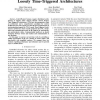33 search results - page 6 / 7 » Abstraction of Clocks in Synchronous Data-Flow Systems |
ISCAS
2006
IEEE
13 years 11 months ago
2006
IEEE
Abstract—We present a silicon neuron that uses shunting inhibition (conductance-based) with a synaptic rise-time to achieve synchrony. Synaptic rise-time promotes synchrony by de...
JSAC
2011
13 years 21 days ago
2011
Abstract—In decentralized cognitive radio (CR) networks, enabling the radios to establish a control channel (i.e., “rendezvous” to establish a link) is a challenging problem....
WDAG
2004
Springer
13 years 11 months ago
2004
Springer
Abstract. Version vectors play a central role in update tracking under optimistic distributed systems, allowing the detection of obsolete or inconsistent versions of replicated dat...
CSFW
2008
IEEE
14 years 6 days ago
2008
IEEE
Abstract. The focus of work on information flow security has primarily been on definitions of security in asynchronous systems models. This paper considers systems with scheduler...
EMSOFT
2010
Springer
13 years 3 months ago
2010
Springer
Abstract--Cyber-Physical Systems require distributed architectures to support safety critical real-time control. Kopetz' Time-Triggered Architectures (TTA) have been proposed ...

